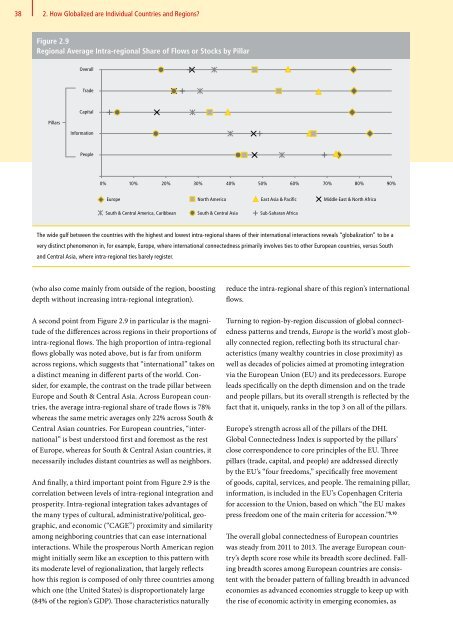DHL Global Connectedness Index 2014
DHL Global Connectedness Index 2014
DHL Global Connectedness Index 2014
- No tags were found...
You also want an ePaper? Increase the reach of your titles
YUMPU automatically turns print PDFs into web optimized ePapers that Google loves.
38 2. How <strong>Global</strong>ized are Individual Countries and Regions<br />
Figure 2.9<br />
Regional Average Intra-regional Share of Flows or Stocks by Pillar<br />
Overall<br />
Trade<br />
Pillars<br />
Capital<br />
Information<br />
People<br />
0% 10% 20% 30% 40% 50% 60% 70% 80% 90%<br />
Europe North America East Asia & Pacific Middle East & North Africa<br />
South & Central America, Caribbean South & Central Asia Sub-Saharan Africa<br />
The wide gulf between the countries with the highest and lowest intra-regional shares of their international interactions reveals “globalization” to be a<br />
very distinct phenomenon in, for example, Europe, where international connectedness primarily involves ties to other European countries, versus South<br />
and Central Asia, where intra-regional ties barely register.<br />
(who also come mainly from outside of the region, boosting<br />
depth without increasing intra-regional integration).<br />
A second point from Figure 2.9 in particular is the magnitude<br />
of the differences across regions in their proportions of<br />
intra-regional flows. The high proportion of intra-regional<br />
flows globally was noted above, but is far from uniform<br />
across regions, which suggests that “international” takes on<br />
a distinct meaning in different parts of the world. Consider,<br />
for example, the contrast on the trade pillar between<br />
Europe and South & Central Asia. Across European countries,<br />
the average intra-regional share of trade flows is 78%<br />
whereas the same metric averages only 22% across South &<br />
Central Asian countries. For European countries, “international”<br />
is best understood first and foremost as the rest<br />
of Europe, whereas for South & Central Asian countries, it<br />
necessarily includes distant countries as well as neighbors.<br />
And finally, a third important point from Figure 2.9 is the<br />
correlation between levels of intra-regional integration and<br />
prosperity. Intra-regional integration takes advantages of<br />
the many types of cultural, administrative/political, geographic,<br />
and economic (“CAGE”) proximity and similarity<br />
among neighboring countries that can ease international<br />
interactions. While the prosperous North American region<br />
might initially seem like an exception to this pattern with<br />
its moderate level of regionalization, that largely reflects<br />
how this region is composed of only three countries among<br />
which one (the United States) is disproportionately large<br />
(84% of the region’s GDP). Those characteristics naturally<br />
reduce the intra-regional share of this region’s international<br />
flows.<br />
Turning to region-by-region discussion of global connectedness<br />
patterns and trends, Europe is the world’s most globally<br />
connected region, reflecting both its structural characteristics<br />
(many wealthy countries in close proximity) as<br />
well as decades of policies aimed at promoting integration<br />
via the European Union (EU) and its predecessors. Europe<br />
leads specifically on the depth dimension and on the trade<br />
and people pillars, but its overall strength is reflected by the<br />
fact that it, uniquely, ranks in the top 3 on all of the pillars.<br />
Europe’s strength across all of the pillars of the <strong>DHL</strong><br />
<strong>Global</strong> <strong>Connectedness</strong> <strong>Index</strong> is supported by the pillars’<br />
close correspondence to core principles of the EU. Three<br />
pillars (trade, capital, and people) are addressed directly<br />
by the EU’s “four freedoms,” specifically free movement<br />
of goods, capital, services, and people. The remaining pillar,<br />
information, is included in the EU’s Copenhagen Criteria<br />
for accession to the Union, based on which “the EU makes<br />
press freedom one of the main criteria for accession.” 9,10<br />
The overall global connectedness of European countries<br />
was steady from 2011 to 2013. The average European country’s<br />
depth score rose while its breadth score declined. Falling<br />
breadth scores among European countries are consistent<br />
with the broader pattern of falling breadth in advanced<br />
economies as advanced economies struggle to keep up with<br />
the rise of economic activity in emerging economies, as





